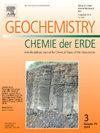Late Jurassic to Early Cretaceous mafic to felsic magmatism reveals the coupled processes of crustal growth and thinning in Southeast China
IF 2.9
3区 地球科学
Q2 GEOCHEMISTRY & GEOPHYSICS
引用次数: 0
Abstract
The study investigates the petrogenesis, deep magmatic processes, and tectono-magmatic evolution of Late Jurassic to Early Cretaceous mafic-felsic igneous rocks from the Guangdong-Fujian border area in Southeast China, using detailed field, petrographic observation, zircon U-Pb geochronology, Hf isotopes geochemistry, bulk-rock major-trace elements and Sr-Nd isotope geochemistry. Zircon U-Pb dating reveals three distinct magmatic activities. The Late Jurassic (ca. 152 Ma) granitoids, identified as fractionated both I-type and A-type granites, exhibit low εHf (t) (−8.3 to −1.9) values and enriched Sr-Nd isotopes that are consistent with melting of psammitic sources. The Late Cretaceous complex (ca. 105 Ma) with initial 87Sr/86Sr ratios (0.7059 to 0.7067) and εNd (t) values (−4.0 to −2.9), together with relatively high εHf (t) values (−5.6 to 1.4), suggesting binary mixing of melts from psammitic and basaltic sources. The Cenozoic mafic rocks display varied 87Sr/86Sr ratios (0.7048 and 0.7096) and positive εNd (t) values (4.0 and 1.0), indicating an asthenospheric mantle source. Fractional crystallization played a key role in the magmatic evolution of the rocks. The Late Jurassic magmatism may indicate that Southeast China was primarily under a setting of lithospheric extension since 152 Ma, driven by slab rollback. The Late Cretaceous magmatism reflects large-scale lithospheric extension and thinning, triggered by a change in the subduction direction of the Palaeo-Pacific slab from oblique to parallel with the continental margin. Our data suggest that the rollback of the subducted Palaeo-Pacific slab in the Guangdong-Fujian border region created a back-arc extensional setting, leading to substantial crustal thinning. The extension-induced melting of the middle to lower crust, combined with mantle-derived basaltic magma underplating, were primary drivers of granitoid magmatism in Southeast China during the Late Jurassic to Early Cretaceous. In the extensional environment, crustal growth and thinning were interconnected, forming a unified geological process.
晚侏罗世—早白垩世基性—长英质岩浆作用揭示了东南地区地壳生长与减薄的耦合过程
通过野外详细考察、岩石学观测、锆石U-Pb年代学、Hf同位素地球化学、块状岩石主微量元素和Sr-Nd同位素地球化学等方法,研究了东南粤闽边区晚侏罗世至早白垩世镁质-长英质火成岩的岩石成因、深部岩浆过程和构造岩浆演化。锆石U-Pb测年揭示了三种不同的岩浆活动。晚侏罗世(约152 Ma)花岗岩为分选的i型和a型花岗岩,其εHf (t)值较低(−8.3 ~−1.9),Sr-Nd同位素富集,与砂质源熔融作用一致。晚白垩世杂岩(约105 Ma)初始87Sr/86Sr比值(0.7059 ~ 0.7067),εNd (t)值(- 4.0 ~ - 2.9),εHf (t)值(- 5.6 ~ 1.4)较高,显示出砂质和玄武岩熔体的二元混合。新生代基性岩87Sr/86Sr比值分别为0.7048和0.7096,εNd (t)值分别为4.0和1.0,表明其为软流圈地幔源。分离结晶在岩石的岩浆演化中起着关键作用。晚侏罗世岩浆活动表明,中国东南部自152 Ma以来主要处于板块回退驱动的岩石圈伸展背景下。晚白垩世岩浆活动反映了古太平洋板块俯冲方向由斜向平行于大陆边缘的变化所引发的大规模岩石圈伸展和减薄。我们的数据表明,粤闽边界地区俯冲古太平洋板块的回滚形成了弧后伸展环境,导致地壳大幅减薄。中、下地壳的伸展熔融作用和幔源玄武岩岩浆是中国东南部晚侏罗世至早白垩世花岗岩类岩浆活动的主要驱动因素。在伸展环境下,地壳生长与减薄相互联系,形成一个统一的地质过程。
本文章由计算机程序翻译,如有差异,请以英文原文为准。
求助全文
约1分钟内获得全文
求助全文
来源期刊

Chemie Der Erde-Geochemistry
地学-地球化学与地球物理
CiteScore
7.10
自引率
0.00%
发文量
40
审稿时长
3.0 months
期刊介绍:
GEOCHEMISTRY was founded as Chemie der Erde 1914 in Jena, and, hence, is one of the oldest journals for geochemistry-related topics.
GEOCHEMISTRY (formerly Chemie der Erde / Geochemistry) publishes original research papers, short communications, reviews of selected topics, and high-class invited review articles addressed at broad geosciences audience. Publications dealing with interdisciplinary questions are particularly welcome. Young scientists are especially encouraged to submit their work. Contributions will be published exclusively in English. The journal, through very personalized consultation and its worldwide distribution, offers entry into the world of international scientific communication, and promotes interdisciplinary discussion on chemical problems in a broad spectrum of geosciences.
The following topics are covered by the expertise of the members of the editorial board (see below):
-cosmochemistry, meteoritics-
igneous, metamorphic, and sedimentary petrology-
volcanology-
low & high temperature geochemistry-
experimental - theoretical - field related studies-
mineralogy - crystallography-
environmental geosciences-
archaeometry
 求助内容:
求助内容: 应助结果提醒方式:
应助结果提醒方式:


